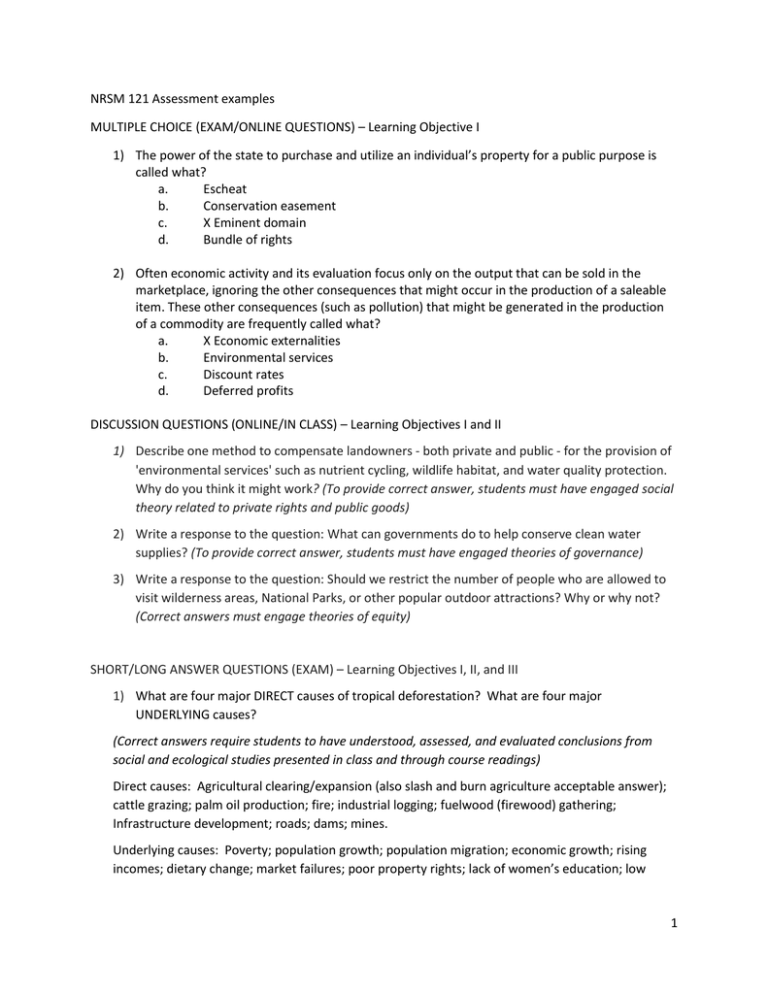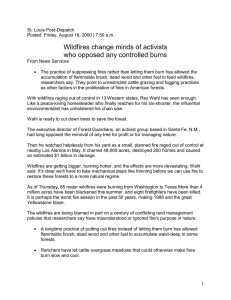NRSM 121 Assessment examples
advertisement

NRSM 121 Assessment examples MULTIPLE CHOICE (EXAM/ONLINE QUESTIONS) – Learning Objective I 1) The power of the state to purchase and utilize an individual’s property for a public purpose is called what? a. Escheat b. Conservation easement c. X Eminent domain d. Bundle of rights 2) Often economic activity and its evaluation focus only on the output that can be sold in the marketplace, ignoring the other consequences that might occur in the production of a saleable item. These other consequences (such as pollution) that might be generated in the production of a commodity are frequently called what? a. X Economic externalities b. Environmental services c. Discount rates d. Deferred profits DISCUSSION QUESTIONS (ONLINE/IN CLASS) – Learning Objectives I and II 1) Describe one method to compensate landowners - both private and public - for the provision of 'environmental services' such as nutrient cycling, wildlife habitat, and water quality protection. Why do you think it might work? (To provide correct answer, students must have engaged social theory related to private rights and public goods) 2) Write a response to the question: What can governments do to help conserve clean water supplies? (To provide correct answer, students must have engaged theories of governance) 3) Write a response to the question: Should we restrict the number of people who are allowed to visit wilderness areas, National Parks, or other popular outdoor attractions? Why or why not? (Correct answers must engage theories of equity) SHORT/LONG ANSWER QUESTIONS (EXAM) – Learning Objectives I, II, and III 1) What are four major DIRECT causes of tropical deforestation? What are four major UNDERLYING causes? (Correct answers require students to have understood, assessed, and evaluated conclusions from social and ecological studies presented in class and through course readings) Direct causes: Agricultural clearing/expansion (also slash and burn agriculture acceptable answer); cattle grazing; palm oil production; fire; industrial logging; fuelwood (firewood) gathering; Infrastructure development; roads; dams; mines. Underlying causes: Poverty; population growth; population migration; economic growth; rising incomes; dietary change; market failures; poor property rights; lack of women’s education; low 1 value of forests; taxation policies; subsides; corruption; lack of stable/strong forest management institutions. 2) What are three factors leading to the extinction of species? What is the name of the law in the United States protecting species from extinction? (Correct answers require students to have understood, assessed, and evaluated conclusions and generalizations drawn from social and ecological studies presented in class and through course readings) Habitat destruction; habitat degradation; hunting; alien or invasive species. The Endangered Species Act. (1973) 3) Why should humanity try to save species from extinction? Provide at least three reasons, and for each reason, explain WHY this reason is important to human interests. (Correct answers must engage social theories related to environmental ethics) Reasons to save a species from extinction are (a) their utility to humans in the forms of drugs, food, medicines, or other useful products; (b) their provision of vital ecological services and/or the creation of a biological infrastructure; (c) their beauty and aesthetic, (d) the moral obligation to keep them. There are multiple reasons for each of these reasons, and the quality of an answer will depend on the fullness of the explanation. 4) Name three key problems facing the management of the National Forests. What would YOU recommend that the Forest Service does about each of these problems? (Correct answers require students to have understood, assessed, and evaluated conclusions from social and ecological studies presented in class and through course readings) Key problems facing the management of National Forests are: Global Climate Change Population pressure on forest lands Wildfire Insects and/or disease Water regulation Invasive species Recreation and access Struggling markets for wood products What I would do: Reinvest in the Forest Service Protect roadless areas Revise forest planning regulations 2 Confront private land development with many tools – better county level planning, tax incentives, land acquisition programs, regulatory oversight for critical areas such as riparian areas Restore forests with treatments that mimic nature Reduce road density Clarify current legal standards for environmental review Conduct a national-level policy review 5) The Rocky Mountain region is a fire adapted set of ecosystems. Discuss the history of the relationship of humans and fire in the Rocky Mountain region. Describe 4 consequences to the forest of the commonly applied policy, sometimes known as the “Smokey Bear” policy, where wildfires are immediately suppressed. (Correct answers require students to draw justified conclusions based on a variety of social (and ecological) data presented in class and through course readings) Humans have a long relationship with fire, and in North American it might be divided into four phases: (1) The Native American era when fire is utilized periodically and judiciously by native people to clear trees for improved forage for hunting game animals and for sustaining natural processes into which their cultures were highly adapted; (2) The settlement era comes next, when early Euro-American used fires extensively to create better conditions for mining, agriculture, and grazing livestock; (3) The “Smokey Bear” era where fires are viewed as a “waste” of a valuable timber resources and all fires must be suppressed. A “put out the fire by 10:00 a.m.” policy is adopted; and (4) The Fire Renaissance era where people are trying to return fire to the land to play its crucial ecological role. The widespread application of the “Smokey Bear” policy in the western United States has created a series of unfortunate consequences: • Increased density of trees on sites that commonly had a mix of grasses and trees • Decreased stream flows as a high number of trees absorb significant amounts of water • Shifts in species to more shade tolerant species, such as Douglas fir on Ponderosa pine sites, and more difficulty in the regeneration of some species • An increase in diseases and pests as these pathogens can more easily attack stressed, weakened trees • Decreased wildlife diversity with the loss of the natural “mosaic” of patchy woodlands on western landscapes • Decrease in soil fertility • Larger wildfires that are harder to control because of high density, high fuels, and high suppression costs. 3

